An online project under the direction of the CAPE ANN MUSEUM
inv. 574
Phantom of Boston
c. 1850s Oil on panel 15 x 20 in. (38.1 x 50.8 cm) No inscription found
|
Supplementary Images
Additional material
Explore catalog entries by keywords view all keywords »
Historical Materials
Below is historical information related to the Lane work above. To see complete information on a subject on the Historical Materials page, click on the subject name (in bold and underlined).
"Party boat" is a colloquial term for any kind of small craft adapted or used for taking guests (customarily for hire) on sightseeing trips or fishing for pleasure. (1) The term survives to this day on Cape Ann and other places for vessels engaged in the same activities. (2) In Lane's time, party boating was a calling of opportunity, and a fisherman's boat might be used in season - regularly or occasionally - to take "rusticators" fishing. Likewise, a boat used for its owner's own pleasure might be hired to take sightseers sailing for an afternoon. The latter use is seen in Lane's 1844 view of Gloucester Harbor from Rocky Neck (see the yawl-rigged sailboat in the foreground of Gloucester Harbor from Rocky Neck, 1844 (inv. 14)).
By the early 1850s, summer visitor activity, encouraged by the building of the Pavilion Hotel on Gloucester's waterfront, led to increased pleasure boating activity, if Lane's painting Gloucester Harbor, 1852 (inv. 38) of Pavilion Beach and Sidney Mason's hotel is any indication. (3) Lane's Gloucester Harbor scenes from this decade show a number of pleasure craft suitable for taking passengers for hire (see Fresh Water Cove from Dolliver's Neck, Gloucester, Early 1850s (inv. 45), Coming Ashore near Brace's Rock, Gloucester, Massachusetts, c.1860 (inv. 60), and View of Gloucester from "Brookbank," the Sawyer Homestead, c.1856 (inv. 95)). Small working craft suitable for this purpose are seen in The Old Fort and Ten Pound Island, Gloucester, 1850s (inv. 30), Gloucester Harbor, 1852 (inv. 38) (right foreground), View of Gloucester, 1859 (inv. 91) (foreground), and Watch House Point, 1860 (inv. 292) (right foreground). In View of Gloucester Harbor, 1848 (inv. 97), we see passengers boarding a small sloop-rigged boat hidden by the rocks at Duncan's Point (left middle ground).
In coastal waters south of Gloucester, a few of Lane's paintings offer pleasure craft as candidates for taking paying passengers. Phantom of Boston, c.1850s (inv. 574) depicts a cruising yawl "Phantom" of Boston, beached with hunting gear unloaded alongside while two of the crew await an approaching party in a rowing boat. The location is unidentified, but a possibility is the barrier beach around the marshes of Lynn, Massachusetts, which were once very popular hunting grounds for migrating waterfowl. A second candidate is a small sloop with a party of four on an evening sail off Halfway Rock in Becalmed Off Halfway Rock, 1860 (inv. 344) (far right).
Lane found similar uses of working watercraft in Maine, where the families of a small coastal community would travel by their workboats to a gathering place for a clambake or similar festive outing (see View of Indian Bar Cove, Brooksville, Maine, 1850 (inv. 61)). The artist became a "rusticator" himself when he, Joseph Stevens, and friends explored Mount Desert Island and vicinity in the "General Gates," a sloop-rigged Maine version of a New England Boat (View of Bar Island and Mount Desert Mountains, from the Bay in Front of Somes Settlement, 1850 (inv. 177) and Castine Harbor and Town, 1851 (inv. 272)).
When Lane traveled to New Bedford in 1856 to observe and sketch a regatta held by the New York Yacht Club, he observed and sketched it while on board an unknown vessel near the starting and finishing line, formed by the race committee boat "Emblem" and her yawl-boat.
Close by was a small party boat with observers on board, probably a fishing sloop, given its work-a-day looks. In the ensuing year, Lane painted four detailed views of this race, the party boat appearing in New York Yacht Club Regatta (1), 1856 (inv. 66) (right foreground); New York Yacht Club Regatta (2), 1856 (inv. 270) (right margin); New York Yacht Club Regatta (3), After 1856 (inv. 396) (center); and New York Yacht Club Regatta (4), 1857 (inv. 397) (left foreground). (4)
– Erik Ronnberg
References:
1. M. H. Parry and others, Aak to Zumbra: A Dictionary of the World's Watercraft (Newport News, VA: The Mariners' Museum, 2000), 436.
2. Ibid.
3. Proctor's Able Sheet (a Gloucester newspaper), January 1857: "Gloucester House reopened—refitted—boats always ready to take parties cruising or fishing..."
4. John Wilmerding, Fitz Henry Lane, 2nd ed. (Cape Ann, MA: Cape Ann Historical Association, 2005), 52–54. Lane's 1852 cruise in the Mount Desert region in the sloop "Superior" was reprinted as an appendix to Wilmerding's essay in Paintings by Fitz Hugh Lane (Washington, DC: National Gallery of Art, 1988), 125–26.
Oil on canvas
34 x 45 3/4 in.
Cape Ann Museum, Gloucester, Mass., Gift of Mrs. Jane Parker Stacy (Mrs. George O. Stacy),1948 (1289.1a)
Detail of party boat.
Also filed under: Gloucester Harbor, Inner / Harbor Cove »
Oil on canvas
22 x 36 in.
Cape Ann Museum, Gloucester, Mass., deposited by the Collection of Addison Gilbert Hospital, 1978 (DEP. 201)
Detail of party boat.
Also filed under: Ten Pound Island »
Newspaper
Ad in Gloucester Telegraph
FISHING AND SAILING PARTIES
"Persons desirous of enjoying a SAILING or FISHING EXCURSION, are informed that the subscriber will be in readiness with the Boat EUREKA, to attend to all who may favor him with their patronage. JOHN J. FERSON"
Also filed under: Gloucester Harbor – Use » // Newspaper / Journal Articles »
Newsprint
Ad for Gloucester House
Courtesy of the American Antiquarian Society, Worcester, Mass.
See p. 4, column 2.
Also filed under: Brick Houses / Gloucester House Hotel » // Newspaper / Journal Articles »
Yachts and yachting in ninteenth-century America were the preserve of the wealthy, and in Lane's early career were just beginning to organize as yacht clubs with scheduled regattas. The New York Yacht Club, founded in 1844, was the first such organization and had few rival clubs for racing or cruising until after the Civil War. (1) In Boston, by contrast, yachts of any size were few. Instead of regattas, competition was in the form of match races, between two vessels, with cash prizes as a substitute for trophies. Often, the only serious competition for a Boston-owned yacht was one of the crack pilot schooners, and it was not uncommon for a yacht to be sold for pilot service or vice-versa. (2)
If Lane had opportunity to portray any yachts in Boston, only his depiction of schooner "Northern Light" (see The Yacht "Northern Light" in Boston Harbor, 1845 (inv. 268)) has been found to date, and that was based on a drawing by Robert Salmon. (3) It seems likely that he would have depicted more Boston yachts, some of which images might still exist in private collections not currently accessible. For more depictions of yachts by Lane, we must look to New York.
Lane is known to have made two paintings of the schooner yacht "America." The more familiar one The Yacht "America" Winning the International Race, 1851 (inv. 255) was based on a lithograph derived from a painting by Oswald Brierly who witnessed and sketched "America" as she raced for the trophy that now bears her name. (4)
The other painting Yacht "America" from Three Views, c.1851 (inv. 395) was very possibly based on sketches of the designer's half-model, or even the actual vessel under construction. In either case, Lane's drawings and any notes would have been made before the hull and deck details were finalized. (5)
It would not be until August 8, 1856 that Lane would see and sketch a major yacht regatta—held by the New York Yacht Club at New Bedford, Massachusetts. From this event, he painted four known views, each depicting a different moment in the race. The earliest New York Yacht Club Regatta (3), After 1856 (inv. 396) shows the yachts under way to the starting line, with the smallest yachts (third class) starting at 10:50 a.m. The second class would start at 10:55 a.m. and the first (largest yachts) at 11:00 a.m. The second view New York Yacht Club Regatta (2), 1856 (inv. 270) shows the start of the first class; the third New York Yacht Club Regatta (4), 1857 (inv. 397), the race after the start with the large sloops and schooners taking the lead. The fourth New York Yacht Club Regatta (1), 1856 (inv. 66), depicting the finish, shows the winning sloop "Julia" over the line, lowering her racing sails, while the rest of the fleet follows her to the finish line. (6 and 7)
As interest in yachting increased, so did leisure pursuits in smaller craft, using rowing and sailing boats for rowing, fishing, and day-sailing. These activities had a commercial side which is covered in the Party Boats descriptive essay, but this essay will deal with boats used for non-commercial recreation.
Hull types and rigs for small pleasure craft were varied, some being traditional work boat designs with a few added amenities for comfort. Others were designed and built for leisure boating, often in the styles of yachts, but smaller and simpler. Among rowing boats, the dory was a logical choice, the version in View of Gloucester, (From Rocky Neck), 1846 (inv. 57) (right foreground) being smaller, with a wider bottom for greater stability. New England boats (see Norman's Woe, Gloucester Harbor, 1862 (inv. 1), View of Gloucester, 1859 (inv. 91), and Castine Harbor and Town, 1851 (inv. 272)) are also to be found in settings more akin to leisure than to work. (8)
Sailing craft custom-built for pleasure were also depicted by Lane. Examples with sloop rigs are found in The Old Fort and Ten Pound Island, Gloucester, 1850s (inv. 30) (left foreground), Fresh Water Cove from Dolliver's Neck, Gloucester, Early 1850s (inv. 45) (center left), and Coming Ashore near Brace's Rock, Gloucester, Massachusetts, c.1860 (inv. 60) (right foreground). The yawl rig is seen in View of Coffin's Beach, 1862 (inv. 41) (right middle ground), and schooners in Fresh Water Cove from Dolliver's Neck, Gloucester, Early 1850s (inv. 45) (right middle ground) and View of Gloucester, Mass., 1859 (not published) (foreground). These rigs differ only moderately from today's versions; their hull designs remain popular among admirers and owners of "traditional boats."
– Erik Ronnberg
References:
1. William P. Stephens, Traditions and Memories of American Yachting (Camden, ME: International Marine Publishing Co., 1981), 157–59.
2. Ibid., 159–61, 164–66.
3. John Wilmerding, Fitz Hugh Lane, 1804–1865: American Marine Painter (Salem, MA: Essex Institute,1964), 29–30.
4. Erik A.R. Ronnberg, Jr., "Fitz Henry Lane's Yacht America from Three Views: Vessel Portrait or Artist's Concept?," Antiques & Fine Art (Summer/Autumn 2010): 175.
5. Ibid., 174–79.
6. U.S. Nautical Magazine and Naval Journal V (October 1956–March 1857): 16–18.
7. The American Neptune X, no. 3 (July 1950): 231–34. Reprint of an unidentified newspaper account of the 1856 New Bedford Regatta by Robert Bennet Forbes.
8. See the descriptive essay on "New England Boat."
See p. 163.
Also filed under: "Northern Light" (Yacht) »
Parker & Ditson
Courtesy American Antiquarian Society, Worcester, Mass.
Dedicated to the Tiger Boat Club.
Also filed under: Bufford, J. H. Lith. – Boston » // Parker & Ditson, Pub. – Boston » // Sheet Music by other artists » // Thayer's, Lith. – Boston » // Tiger Boat Club »
The Rudder Vol. XV Part 1–3; pp. 387–390, 456–460, 483–486
"Historic American Yachts: Early Boston Vessels, The Northern Light and Coquette."
Also filed under: "Northern Light" (Yacht) »
wood, metal, cordage
Model of schooner yacht "Northern Light" of Boston, 1839
Scale 1:32
Also filed under: "Northern Light" (Yacht) » // Ship Models »
wood, metal, cordage
Model of schooner yacht "Northern Light" of Boston, 1839
Scale 1:32
Also filed under: "Northern Light" (Yacht) »
Bird hunting was an activity undertaken for both pleasure and by fishermen to protect the drying fish flakes and their nets. During the nesting seasons, the breeding grounds were systematically raided and the absence of seagulls in Lane's harbor scenes can be attributed to the fact that the population of sea birds was controlled. In addition, watchmen with fowling pieces protected the fish flakes.
Personal journal
Wilson Museum, Castine, Maine
Box 2, F1 (A00772)
John Stevens was the younger brother of Joseph Stevens, and acquainted with Lane, spending time with him in Gloucester and at the family home in Castine. His journal, quoted below, includes reference to hunting plover and teal, school, sailing, local events. Mentions Castine mill, lighthouse, and block house.
"Friday [September] 17th: Cloudy all day. Wind N. blowing quite hard. A British Rig loaded with salt from Liverpool came into port last night. She run way up by the Monument and got aground. They kedged her off this P.M. and came down. She came in with one of these old English charts as her guide. They have the town set down on the Brooksville side, two miles + three quarters from the lighthouse."
"Wednesday [September] 22. . .Went down to the Indians Camp on the Back Cove. There were five camps of them."
Visits Gloucester from Castine:
"Wednesday [October] 27th. . .Left for Gloucester [from Boston] at 5 o'clock this P.M. arrived there safe + sound at 6 1/2 o'clock; went right down to the store and saw Joe. We then went up to his house and got supper.
"Thursday [October] 28th. At. Gloucester. Pleasant day. Went down to the "Cut" a gunning this morning before breakfast but saw no birds. Went out in the harbor this forenoon alone, had a fine sail but couldn't get a chance at any birds. Went out again this P.M. got down to East Point Light and the wind died all away, so I had to scull home."
"Friday 29th. Very pleasant day, went out in the harbor this morning with Joe. Took a walk this A.M. with "Lina", called on Mr. Lane + Doct. Hildreth. Joe + I went out in the harbor this P.M. I fired at some birds several times, but didn't get any. . . ."
Also filed under: Biographical information » // Castine » // Castine – School » // Chronology » // Cut, The (Stacy Blvd.) » // Diaries / Ledgers / Etc. » // Stevens, Joseph, Jr. »

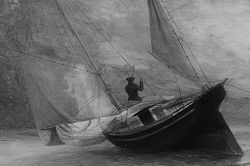

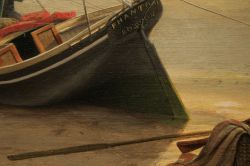
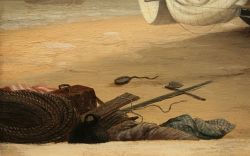
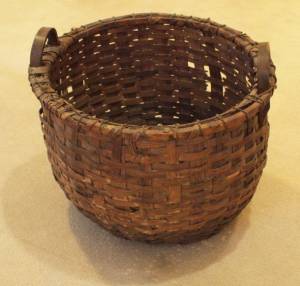

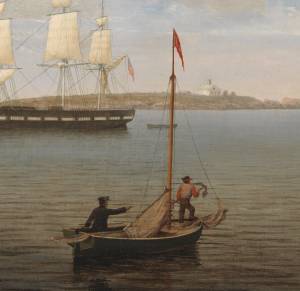
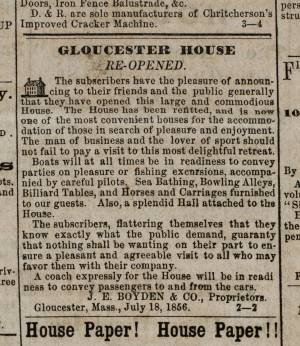
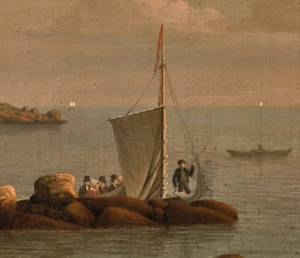
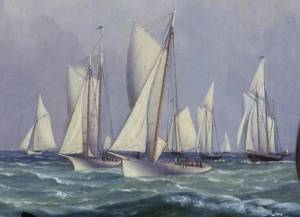
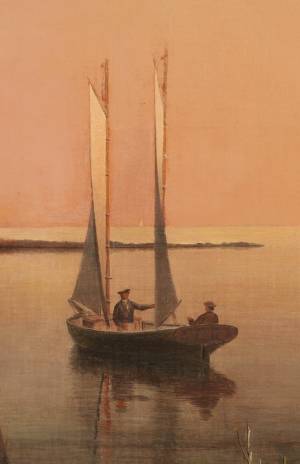



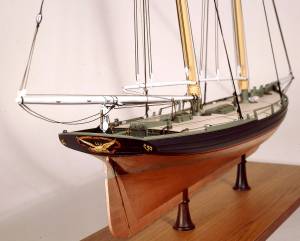
Commentary
(Note: for a fully illustrated version of this commentary, see the article New Discoveries: "Phantom of Boston" Donated to the Cape Ann Museum.)
This remarkable Lane discovery has been a long time in the works. The painting was acquired by Gustav Klimann in the late 1950s from an antiques dealer in Essex, the town immediately west of Gloucester. Mr. Klimann, who died in the 1970s, was a well-known art conservator and restorer in Boston who did work for numerous collectors, galleries and museums in New England from the 1930s through the 1960s. From the first moment he saw the painting, Mr. Klimann thought it was a Lane. He had seen many Lanes (and may have restored some) in the collection of his good friend Maxim Karolik, the pre-eminent collector of F.H. Lane and other nineteenth-century American artists. The Karolik collection had over a dozen Lanes and now forms the backbone of the Museum of Fine Arts Boston's American painting collection.
Mr. Klimann was a knowledgeable collector in his own right with a well-developed eye. The rediscovery of Lane was just starting in the 1940s and 50s after his many years of obscurity. In this era, many Lanes were being sold out of old New England houses in this era (particularly around Gloucester) for nominal prices. Like many of Lane's works, the painting is unsigned, as are many Lanes—the rarity of signed works likely contributed to Lane's long obscurity. The painting was donated to the Cape Ann Museum by Mr. Klimann'a wife Joan Klimann in 2014 in his memory.
The painting is medium-sized, 15 x 20 inches, on a panel of Magnolia wood, an unusual support. Interestingly, the town of Magnolia, which abuts Gloucester to the south, was named for a particularly large grove of native Magnolia trees, at the time thought to have been the northernmost extent of the species range.
The story the painting illustrates remains a mystery. The vessel is a private yacht that has run aground on a sandbar. The contents of the boat have been unloaded onto the beach; a fascinating collection of blankets, leather suitcases, a fish basket (identical to one in the Cape Ann Museum collection), a frying pan, jugs, pots, a kettle, a coil of rope, a hatchet and several rifles. The sail is half-hoisted to dry with the boom ingeniously supported by the boathook stuck into the sand. The smart red cushions lie on the deck to dry. The captain (and presumed owner), with his jaunty cap and tailored jacket, is anxiously looking towards a boat with five men being rowed towards him. The mate on the beach is looking down at a rifle in his hands as if to load it; another rifle is nearby. The sun is rising through a swirling mist.
Several scenarios have been suggested for this narrative. One is that the boat has gone aground and the approaching men in the boat are salvagers. The man on the beach is loading his rifle to keep them at bay while waiting for the tide to float the boat free. The boat's contents have been unloaded in an attempt to save them should the salvagers get the boat. Note the ominous cross made by the hatchet crossing a plank of wood in the lower left, a device Lane used in several paintings, including one of the Brace's Rock series.
A far more benign interpretation is based on marine historian Erik Ronnberg's identification of the vessel's design as British, and its similarity to boats used for duck hunting in the English salt marshes. While the transom clearly shows that the "Phantom" is from Boston, it was not uncommon to transport smaller boats to America from England or to have one built here to specifications. In this interpretation, the captain and crew have been caught overnight in a storm on their way to a duck hunt and have run aground on a sand bar near the salt marshes. Their belongings have been unloaded to dry and the rest of their hunting party is rowing in to help them off the bar—come high tide—and proceed with the duck hunt. Perhaps the boat owner commissioned the painting to memorialize the event.
Whichever the interpretation, this is a scene full of the anecdote and detail typical of so many Lane paintings. Stylistically, there are numerous Lane trademarks, beginning with the remarkable set of objects on both sides of the foreground. They are all skillfully painted and tonally coherent with attention to every detail, including the weave of the basket and the patterns on the blankets. The short-necked man with the gun, whose head and hat seem to grow directly from his shoulders, is another Lane trademark, seen particularly often in his early work. The rigging on the vessel is impeccably painted, a Lane talent that was unmatched by his peers. Note the boathook holding up the boom. This arrangement keeps the sails off the wet sand and also allows Lane to show the folds, drape and weight of the canvas—a subject that Lane treated in every variation throughout his career. The yacht is a beauty, the mahogany companionway doors setting off its painted interior and white masts. With its bright red cushions in place, it must have been a pleasure to sail.
The hull shows all its form and volume lying on its side on the beach. Lane painted an unusual number of works with boats aground, whether for repairs or otherwise. He clearly loved the sculptural forms of the hulls below their waterlines and understood every element of there construction. This is why his boats all sit or move through the water so convincingly: they show their weight and mass as they float, unlike the boats of so many other marine painters that sit a little high and seem detached from the gravity and resistance of the water.
The atmosphere is subtly rendered, with the sun breaking through the mist and casting alternating bands of shadow and light on the beach. The composition is defined by the diagonal of the masts, the angle of the hull, and the line of the rudder. The black triangle of the hull perfectly balances the corresponding white shape of the drying sails. The color scheme is a dramatic black, white and gold with Lane's usual enlivening spot of red.
Beyond stylistic evidence, the final test of Lane authorship is in the underdrawing technique, which can be seen using infrared photography. Based on numerous infrared scans of other Lane paintings, we know that Lane usually did detailed underdrawings in pencil on the canvas before painting. He drew the rigging in particular detail, as can be noted in the scans of numerous Lane ship portraits. In this case, he has drawn every line and stay in pencil, even the flourish of the halyard whipping around the mast in a corkscrew motion. One can also see the subtle adjustments that were made in the stern transom and interior coaming of the cockpit after the drawing.
Lane was not alone in doing underdrawings, but his are distinct from those artists most frequently confused with him. His student Mary Mellen did very little underdrawing, while the marine painter William Bradford, who emulated Lane in his early career, made multiple changes and erasures to his drawings. Lane's drawing shows very few adjustments—perhaps because of his training in lithography his drawing is unerringly accurate from the start.
Research is still ongoing for any record of the yacht or its owner. The painting is so specific in detail that it is hard not to imagine Lane being commissioned to paint the scene, possibly by the gentleman perched on the deck. Unfortunately, pleasure craft were not documented or taxed in that time, unlike commercial vessels, and there is no official record of yacht ownership that has been discovered. There were several large commercial vessels called “Phantom,” but nothing that could be confused with this boat. If Lane did do the painting on commission, there was likely to have been some kind of receipt; possibly even a letter between the owner and Lane describing the scene. As is so often the case with Lane, though, the paper record has disappeared or has yet to be found.
– Sam Holdsworth
[+] See More